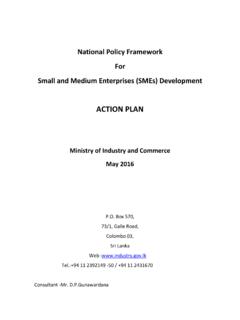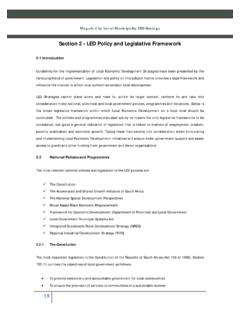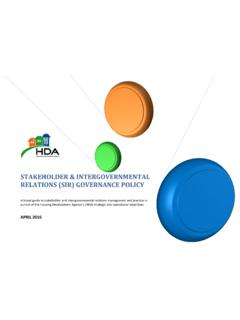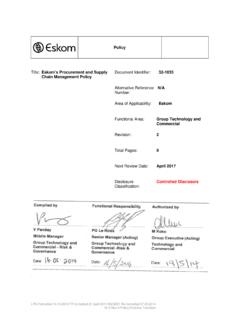Transcription of Table of Contents - Ministry of Industry and …
1 Table of Contents Page 1. Introduction .. 1. 2. Vision, Mission and Objectives of the SME policy framework .. 1-2. 3. Definition of SMEs .. 3. 4. High Potential Promising Clusters 4. 5. policy Interventions and Strategies . 5. a. Enabling Environment 5. b. Modern Appropriate Technology 6. c. Entrepreneurial Culture and Skills Development .. 7. d. Access to Finance .. 8. e. Market Facilitation .. 8. f. Research and Development .. 9. g. Resource Efficiency .. 10. h. Regional Balance .. 11. 6. Implementation Arrangements.
2 11. a. Coordination for the Implementation of the policy 11. b. SME Advisory Council .. 12. c. SME Cluster Committees 12. d. Monitoring and Evaluation .. 13. 7. Conclusion .. 13. Tables Table I: Defining SME in Sri Lanka .. 3. Figures Figure 1: SME policy framework Matrix .. 3. National policy framework for Small Medium Enterprise (SME) Development 1. Introduction The Small Medium Enterprise (SME) sector has been identified as an important strategic sector in the overall policy objectives of the Government of Sri Lanka (GOSL) and it is seen as a driver of change for inclusive economic growth, regional development, employment generation and poverty reduction.
3 SME sector is envisaged to contribute to transform lagging regions into emerging regions of prosperity. The Government of Sri Lanka recognizes SMEs as the backbone of the economy, as it accounts for more than 75% of the total number of enterprises, provides 45% of the employment and contributes to 52% of the Gross Domestic Production (GDP).SMEs promote broad based equitable development and provide more opportunity for Women and Youth participation in the economic development of the country. With the globalization trend, the SME sector is not merely seen as a sector for protection and promotion but, more importantly as driving force for growth and development.
4 Therefore, Government of Sri Lanka recognizes that enhancing national and international competitiveness is fundamentally important for this sector to face the emerging challenges and develop SMEs as a thriving sector. Given the nature of this sector and the challenges faced, it is important to have a Government led intervention and support mechanism to upgrade and strengthen this sector to meet the expectations of the country. This SME policy framework aims to promote high potential, promising SMEs and improve business environment to allow them to realize their full potentials in today's globalized economy.
5 This policy framework will foster small enterprises to grow into medium sized enterprises and medium sized enterprises to grow into large enterprises and large enterprises to grow into globally competitive enterprises. 2. Vision, Mission and Objectives of the SME policy framework policy Vision The vision of the National SME policy framework is to create significant number of globally competitive, dynamic, innovative, technologically driven, eco-friendly and sustainable SMEs that contribute greatly to the national economic development.
6 policy Mission The mission of the National SME policy framework to stimulate growth of SMEs to produce world class products& services that can compete locally and internationally with supportive enabling environment and interventions of technology transfer, entrepreneur culture, skills development, access to finance, market facilitation and research and development. National policy framework for SME Development Page 1. policy Objectives The SME policy framework will support start-up SME enterprises, strengthen the existing enterprises and extend nursing programmes for potentially viable sick SMEs.
7 SME policy will focus on the following aspects. Promoting high potential, viable and promising sectors Focus on cluster approach for SME Development. Under the cluster approach, the entire value chain from input supply to processing and export will be supported and promoted. Promote enterprises with high value addition and encourage enterprises that use the local raw materials as they offer strong comparative advantages due to factor endowments. Motivate and encourage export oriented or import substitution enterprises and industries.
8 Encourage and promote flagship SME sectors with high potential spillover effects to facilitate job creation or employment generation. Promotion and relocation of industries in the backward regions to reduce urban-rural imbalances. Transforming the landscape of the SMEs away from mere trade and commerce towards production and Industry based with special focus on high value addition, innovative and usage of modern appropriate technology. Strengthening the SME sector in order to enhance inclusive economic development and thus provide opportunities for better employment and higher income.
9 Achieve regionally balanced growth across Sri Lanka. Promote resource efficiency at all levels including the use of Green Technology The SME policy framework will also give special attention to maintain nature's capital, green growth, entrepreneurship development, women entrepreneurship, craft sector and promising industrial clusters by strengthening enterprise villages, handicraft villages, Industrial production villages and SME industrial estates / zones. National policy framework for SME Development Page 2.
10 Figure1: SME policy framework Matrix 3. Definition of SMEs The term SME is used to denote micro, small and medium enterprises. Different countries use different definitions for SMEs based on their level of development. The commonly used yardsticks are total number of employees, annual turnover and total investment. In the Sri Lankan context, the SME policy framework defines SMEs based on the number of employees and annual turnover. National policy framework for SME Development Page 3. Table 1: Defining SMEs in Sri Lanka Size Criteria Medium Small Micro Sector Manufacturing Annual Turnover Rs.








